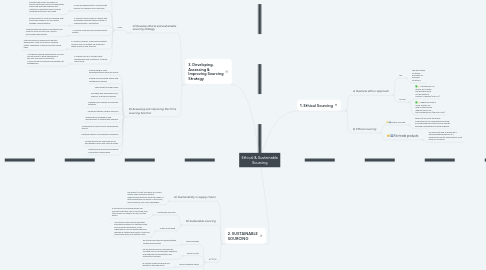
1. 3. Developing, Assessing & Improving Sourcing Strategy
1.1. A) Develop ethical and sustainable sourcing strategy
1.1.1. STEP
1.1.1.1. 1. Establish corporate ethical and sustainable sourcing policies.
1.1.1.1.1. Establishes a vision and direction and enforces the importance of ethical and sustainable sourcing.
1.1.1.2. 2.Train purchasing staff; communicate policies to suppliers and customers.
1.1.1.2.1. Ensures that buyers are skilled in environmental and social considerations insourcing and that suppliers and customers understand why and how purchasing decisions are made.
1.1.1.3. 3. Prioritize items based on ethical and sustainable opportunities and ease of implementation. Get started.
1.1.1.3.1. Allows buyers to “pick low hanging fruit” to provide evidence for successful strategy implementation.
1.1.1.4. 4. Develop a performance measurement system.
1.1.1.4.1. Measurement provides accountability and a way to improve over time. Should be reviewed periodically.
1.1.1.5. 5. Monitor progress, make improvements. Increase use of certified fair trade and green products and services.
1.1.1.5.1. Use performance measures to identify weaknesses. Step up efforts to develop better capabilities in the firm and its supply base.
1.1.1.6. 6. Expand focus to include other departments and customers. Increase brand value.
1.1.1.6.1. Use the purchasing department’s success and influence to grow awareness in the firm and among customers. Communicate successes and programs to stakeholders.
1.2. B) Assessing and improving the firm’s sourcing function
1.2.1. participating in value engineering/value analysis efforts
1.2.2. finding and evaluating ethical and sustainable suppliers
1.2.3. optimizing the supply base
1.2.4. managing and developing local, regional, and global suppliers
1.2.5. creating early supplier involvement initiatives
1.2.6. creating strategic supplier alliances
1.2.7. furthering the integration and development of existing key suppliers
1.2.8. contributing to new product development efforts
1.2.9. initiating supplier cost reduction programs
1.2.10. contributing to the improvement of purchased product and service quality
1.2.11. maintaining and improving internal cooperative relationships
2. 2. SUSTAINABLE SOURCING
2.1. A) Sustainability in supply chains
2.1.1. the ability to meet the needs of current supply chain members without hindering the ability to meet the needs of future generations in terms of economic, environmental, and social challenges.
2.2. B) Sustainable sourcing
2.2.1. Sustainable sourcing
2.2.1.1. A process of purchasing goods and services that takes into account the long term impact on people, profits, and the planet
2.2.2. Green purchasing
2.2.2.1. is a practice aimed at ensuring that purchased products or materials meet environmental objectives of the organization such as waste reduction, hazardous material elimination, recycling, remanufacturing, and material reuse
2.3. ACTION
2.3.1. Grow revenues
2.3.1.1. by introducing new and differentiated sustainable products
2.3.2. Reduce costs
2.3.2.1. by increasing resource efficiencies, avoiding use of noncompliant suppliers, and rethinking transportation and distribution systems.
2.3.3. Build intangible assets
2.3.3.1. by further enhancing brand and reputation through social
2.3.4. Manage risk
2.3.4.1. by managing brand and reputation, and developing approaches for meeting regulations and capturing sustainability-conscious customers.
3. 1. Ethical Sourcing
3.1. A, Business ethics' approach
3.1.1. Def
3.1.1.1. the application of ethical principles to business situations
3.1.2. Include
3.1.2.1. Utilitarianism: an ethical act creates the greatest good for the greatest number of people (ABILITY)
3.1.2.2. Rights and Duties: some actions are right in themselves without regard for the consequences (OBLIGATION)
3.2. B, Ethical sourcing
3.2.1. Ethical sourcing
3.2.1.1. takes into account the public consequences of organizational buying, or bringing about positive social change through organizational buying behavior.
3.2.2. Fair trade products
3.2.2.1. are manufactured or grown by a disadvantaged producer in a developing country that receives a fair price for its goods
